Archivo de noticias y eventos
1001 - 1050 de un total de 2402
También puede acceder a la lista de noticias publicadas en los medios relacionadas con el Instituto de Astrofísica de Andalucía - CSIC.
Pages

|
01/06/2017 - 12:30
Servicios Administrativos en el IAA La actividad científica e investigadora en el IAA, requiere el apoyo y soporte de gestión de las unidades de servicios administrativos. Estas se componen de los servicios económico-administrativos y los servicios generales (Biblioteca, Mantenimiento, Ordenanzas). Estas unidades gestionan los medios y recursos materiales, económicos y personales que el IAA tiene asignado. Se expondrá una visión general de los servicios, con la tareas... Fernado Bordons, Gerente del IAA |

|
08/06/2017 - 12:30
The Dynamic Universe: Adventures in Time Series Analysis Modern astrophysics has revealed a Universe alive with explosions great and small. It is an astonishingly active place, far different from the serene “clockwork Universe” previously envisioned. Our tour of this dynamic Universe includes the active Sun, extrasolar planets and the search for intelligent life on them, the highly active relativistic plasma that is the residue of a stellar explosion in the year 1054 AD, dramatic x-ray... Dr. Jeff Scargle |

|
21/03/2017
La misión Rosetta permite describir cómo cambia la superficie de un cometa en su paso alrededor del Sol El análisis comparativo de la superficie del cometa 67P antes y después del perihelio, o punto de la órbita más cercano al Sol, muestra numerosos cambios en su orografía, pero no a gran escala. El trabajo, publicado en la revista Science, sugiere que los grandes relieves del cometa 67P datan de épocas anteriores, y más activas, en la historia del cometa |

|
09/05/2017 - 12:30
Blender 3D, el programa definitivo Blender es un potente programa multiplataforma que se distribuye libremente y es de código abierto. Entre sus aplicaciones más inmediatas está el modelado y la animación 3D, pero es un programa muy versátil que se puede usar para muchos otros propósitos. En esta charla presentaremos ejemplos de uso de Blender para la visualización de datos científicos y divulgación de la Ciencia; para la creación de diseños y piezas tridimensionales que pueden... Dr. Francisco M. Gómez Campos |

|
20/04/2017 - 12:30
Spatially resolved star formation history of CALIFA galaxies: Implications for galaxy formation One year after the final data release of the CALIFA survey, I will revise the results obtained from the analysis of the spatially resolved stellar population properties of galaxies and their impact on our knowledge on galaxy formation and their evolution. I will do special emphasis in the more recent results on the spatially resolved star formation histories of galaxies obtained for our group at the IAA. I will show, in my opinion, the... Prof. Rosa González Delgado |

|
06/04/2017 - 12:30
Fractal analysis in pulsating stars: what is and what we can learn from it I will describe the basic ideas of my line of research, concerning the develop of classification criteria and algorithms for the identification of delta Scuti, gamma Doradus and Solar-like pulsating stars, based on chaos analysis and multi-fractal analysis. In fact multi-fractal behaviour in light curves, which emerges at the onset of chaos, could be the fingerprint of the stochastic mechanism of modes excitation, due to an outer convective... Dr. Sebastiano de Franciscis |
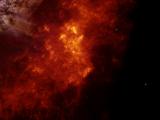
|
14/03/2017
SN2015bh: ¿el fin de una estrella o una supernova "impostora"? Se ha detectado una intensa explosión en una estrella muy masiva que, según los registros, lleva más de veinte años sufriendo erupciones. El análisis del estallido no permite distinguir si se trata de una supernova, un evento explosivo que pone fin a la vida de la estrella, o de una erupción gigantesca que anticipa un cambio evolutivo |

|
27/04/2017 - 12:30
The large abundance discrepancy phenomenon in planetary nebulae The discrepancy between chemical abundances computed using optical recombination lines (ORLs) and collisionally excited lines (CELs) is a major unresolved problem in nebular astrophysics, with significant implications for the determination of chemical abundances throughout the Universe. In planetary nebulae (PNe), a common explanation of this discrepancy is that two different gas phases coexist: a hot component with standard metallicity, and a... Dr. Jorge García Rojas |
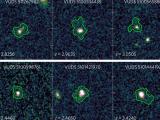
|
07/03/2017
Se hallan unas "gemelas" de las galaxias primigenias que permiten estudiar las etapas iniciales de la formación galáctica Las galaxias primigenias datan de las edades oscuras, un periodo cosmológico difícil de observar en detalle debido a la presencia de hidrógeno neutro, un gas que aumenta la opacidad del medio. El hallazgo de galaxias análogas, que datan de un tiempo algo posterior pero que presentan las mismas características que las galaxias primigenias, ha permitido estudiar el proceso en detalle |
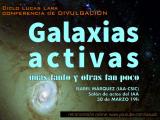
|
30/03/2017 - 19:00
Galaxias activas: unas tanto y otras tan poco Muchas galaxias del universo, incluida nuestra propia Vía Láctea, contienen en sus centros agujeros negros supermasivos (de entre unos pocos millones hasta miles de millones de veces la masa del sol). Pero en solo una pequeña fracción de esas galaxias, las llamadas “galaxias activas”, se activan en sus núcleos una serie de mecanismos que pueden llegar a ser muy violentos. Isabel Márquez |

|
23/03/2017 - 12:30
Detection of gravitational waves from space: the LISA mission The idea of detecting gravitational waves from space has been under consideration for more than 25 years. In 2012, the advisory bodies of ESA decided that the next-but-one "large mission", L3, will be devoted to this. Launch is scheduled for 2034. In 2015, the Director of Science of ESA appointed an external committee, with Michael Perryman as chair, to advise on the technical feasibility of the LISA mission, and the technology development... Prof. M. Perryman |

|
16/03/2017 - 12:30
Space astrometry: the Hipparcos and Gaia missions The talk will provide a short historical context and describe the scientific motivation for these missions, outline the essential experimental principles which underpin their measurements, and give an overview of the science objectives, including Gaia's expected yield of many thousands of astrometrically-detected exoplanets. Prof. M. Perryman |
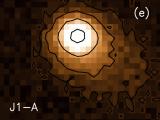
|
28/02/2017
P/2016 J1: el asteroide que se rompió y cuyos fragmentos, años después, desarrollaron colas Los asteroides, a diferencia de los cometas, no se caracterizan por exhibir una cola, pero se conocen unas veinte excepciones. P/2016 J1 constituye un caso peculiar, ya que se trata de lo que se conoce como "par de asteroides", producto de la fractura de un asteroide progenitor |

|
30/03/2017 - 12:30
Star formation in nearby early-type galaxies It is well known that there is little star formation activity in early-type galaxies. By cross-matching SDSS DR 7 with RC3 catalog and visually checking the SDSS images, we derive a sample of 583 S0 galaxies with the central spectrophotometric information. In order to separate nebular emission lines from the underlying stellar contribution, we fit the stellar population model to the SDSS spectra of these S0 galaxies. According to the BPT diagram... Dr. Qiusheng Gu |
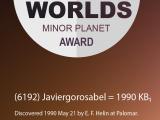
|
17/02/2017
El astrofísico Javier Gorosabel da nombre a un asteroide La IAU ha nombrado el asteroide 1990KB1 en honor de nuestro compañero Javier Gorosabel (1969-2015), rindiendo homenaje a su trabajo científico y divulgador |
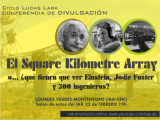
|
23/02/2017 - 19:00
El Square Kilometre Array. O... ¿qué tienen que ver Einstein, Jodie Foster y 300 ingenieros? Próxima conferencia de divulgación del ciclo Lucas Lara Lourdes Verdes-Montenegro |

|
02/03/2017 - 12:00
Supermassive Black Holes: Impact on Galaxy Formation and Evolution Supermassive black holes, weighing between millions to billions times the mass of the Sun, are believed to power quasars and other energetic activity in the centers of galaxies. With the help of advanced telescopes from the ground and in space, operating across the electromagnetic spectrum, astronomers have now discovered that supermassive black holes not only exist, but that they are very common and play a critical role in the formation and... Prof. Luis Ho |

|
09/02/2017
11 de febrero. Día internacional de la mujer y la niña en la ciencia El 11 de febrero, por decisión de la Asamblea General de las Naciones Unidas, se celebra el Día Internacional de la Mujer y la Niña en la Ciencia. |

|
09/03/2017 - 12:30
Recovering information beyond the power spectrum of large-scale structure Future galaxy surveys of the large-scale structure in the Universe will provide a wealth of new data and make it possible to use higher-order statistics beyond the power spectrum, such as the bispectrum (or 3-point correlation function), to constrain galaxy clustering, the standard LCDM cosmology, and many of its possible extensions. However, it may be possible and preferable to use recently devised alternative statistics, such as the line... Dr. Joyce Byun |

|
23/02/2017 - 12:30
The impact of environment and confusion of the observed HI galaxy population The HI galaxy mass function represents a fundamental component of our understanding of the gas content of galaxies. How its form varies throughout the local Universe and as a function of redshift is key to developing a complete picture of galaxy evolution. We use the ALFALFA 70% catalogue, the largest uniform catalogue of extragalactic HI sources to date, to explore the environmental dependence of the HI mass function based on the projected... Michael Jones |

|
19/01/2017
FITUR 2017: Susana Díaz respalda la Oficina de calidad del cielo puesta en marcha por el IAA La presidenta de la Junta de Andalucía, Susana Díaz, ha mostrado su apoyo a la Oficina de calidad del cielo del IAA en FITUR 2017 |
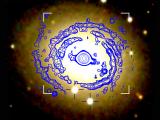
|
19/01/2017
Se observan brotes de formación estelar en un tipo de galaxias donde, en teoría, ya no nacen estrellas El proyecto CALIFA ha permitido detectar, en tres galaxias elípticas, unos brazos muy tenues donde se están formando estrellas. Los datos, obtenidos con el telescopio de 3,5 metros del Observatorio de Calar Alto, contradicen la creencia generalizada de que en las galaxias viejas no nacen estrellas |
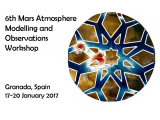
|
17/01/2017 - 20/01/2017
Mars Atmosphere Modelling and Observation Granada |
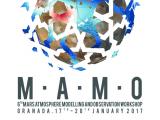
|
16/01/2017
La atmósfera de Marte, a debate en Granada Más de ciento cincuenta expertos de todo el mundo se reúnen esta semana en Granada para presentar y debatir los últimos hallazgos sobre la atmósfera del planeta rojo |
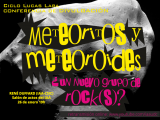
|
26/01/2017 - 19:00
Meteoritos y meteoroides: ¿un nuevo grupo de rock(s)? En esta charla voy a comunicar los últimos conocimientos de los que disponemos sobre los meteoritos y los meteoroides y su relación con los asteroides. René Duffard |

|
12/01/2017 - 12:00
Calar Alto, presente y futuro Esta charla pretende dar una visión general del estado actual del observatorio de Calar Alto mostrando los principales hitos conseguidos en los últimos años. La re-apertura de instalaciones, la concesión de nuevas ayudas del MINECO para mejoras de infraestructuras y la celebración del workshop de instrumentación en Granada, ha abierto un nuevo escenario que el observatorio va a afrontar en los próximos años. Dr. Jesús Aceituno, director de CAHA |

|
09/02/2017 - 12:30
Molecular gas and dust in low-metallicity starbursts Metal-poor, star-forming, dwarf galaxies play a fundamental role in galaxy formation and evolution, and according to LambdaCDM models may be the building blocks of most of the galaxies in the universe today. Although the interstellar medium (ISM) in such galaxies was thought to be virtually dust-free, over the last decade, observations have shown that dust can be an important constituent of even a low-metallicity ISM. However, the molecular... Dr. Leslie Hunt |

|
29/12/2016
El Instituto de Astrofísica de Andalucía lanza una aventura gráfica sobre la exploración de Marte ‘Let’s go to Mars’ es una app diseñada para el proyecto europeo UPWARDS, desarrollada en colaboración con las empresas Wild Sphere y Laniakea Management & Communication y cofinanciada con fondos FECYT. A través de la exploración de diferentes zonas marcianas, la recolección de minerales y piezas de misiones anteriores, el jugador tendrá que construir la primera colonia humana en el planeta rojo y superar múltiples peligros |

|
16/02/2017 - 12:30
Cold plasma and magnetic reconnection at the magnetopause boundary layer Magnetic reconnection is a fundamental plasma process that permits the exchange of energy and mass between colliding plasmas, e.g., between the Solar Wind and the Earth's magnetosphere. Several studies have reported the presence of cold plasma of ionospheric origin at the magnetospheric side of the magnetopause boundary layer. As a result, the particle distribution functions involved in reconnection are far from equilibrium, exhibiting a cold... Dr. Sergio Toledo Redondo |

|
02/02/2017 - 12:00
Living on the Edge: Superthin Galaxies and the Cosmic UV Background Superthin galaxies are bulgeless, late-type spiral galaxies seen edge-on. HI synthesis observations probe the kinematic structure of their interstellar medium. Observations of these isolated, quiescent galaxies have reached column densities as low as few x 1018 atoms . cm-2 . The simple structure of the superthins makes them ideal cosmological laboratories (Uson and Matthews, Astron. J. 125, 2455, 2003). I shall present the results of high-... Prof. Juan Usón |
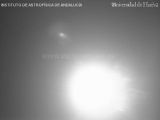
|
12/12/2016
Bólido sobre Granada el 11 de diciembre de 2016 A las 22:25 de la noche (hora local) del 11 de diciembre una brillante bola de fuego cruzó el sur de España y fue registrado por el Observatorio de Sierra Nevada. |
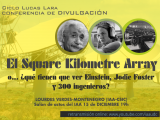
|
15/12/2016 - 19:00
El Square Kilometre Array. O... ¿qué tienen que ver Einstein, Jodie Foster y 300 ingenieros? Próxima conferencia de divulgación del ciclo Lucas Lara Lourdes Verdes-Montenegro |
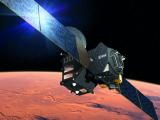
|
30/11/2016
Los primeros datos confirman que NOMAD podrá poner fin al misterio del metano en Marte Los datos de NOMAD, un espectrógrafo codesarrollado por el Instituto de Astrofísica de Andalucía (IAA-CSIC) para la misión ExoMars, confirman el perfecto funcionamiento del instrumento |
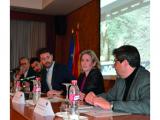
|
28/11/2016
El IAA acoge las II Jornadas de divulgación inclusiva de la ciencia Las jornadas buscan mostrar los proyectos de divulgación más inclusivos, compartir estrategias de enseñanza accesible y dar voz a científicos con discapacidad |
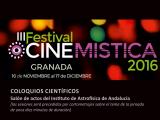
|
24/11/2016 - 11:15
Azar y complejidad (coloquio en el marco del festival Cinemística) Parece que el azar juega un papel esencial a la hora de que en un sistema se generen estructuras complejas. ¿Qué se entiende por sistemas complejos?, ¿hay un aumento de complejidad en la naturaleza con el tiempo?, ¿puede un sistema determinista generar complejidad? Enrique Pérez (astrofísico), Enrique Iáñez (biólogo) y Juan Manuel García Ruiz (geólogo) |

|
28/11/2016
II Jornadas de divulgación inclusiva de la ciencia Un foro de encuentro para mostrar los proyectos de divulgación de la ciencia más inclusivos, compartir estrategias de enseñanza accesible, mostrar materiales y recursos que hagan los contenidos accesibles para todos y dar voz a científicos discapacitados que quieran compartir su experiencia investigadora |

|
18/11/2016
Variaciones de brillo en la superficie del 67P muestran la complejidad de la actividad cometaria Este trabajo, publicado en la revista Science y que ha contado con la participación de investigadores del Departamento del Sistema Solar del IAA-CSIC, analiza los cambios temporales en la luz reflejada por la superficie del cometa 67P/Churyumov-Gerasimenko. Para ello ha empleado los datos suministrados por los diferentes filtros de las utilización de las cámaras OSIRIS de la misión ROSETTA que durante dos años ha seguido la evolución del... |

|
31/01/2017 - 12:30
Asteroid surfaces: irradiation and VIS-IR micro-spectroscopy in the laboratory Primitive extraterrestrial materials, such as meteorites and dust collected by sample return missions, are characterized by a large compositional heterogeneity at different scales. This heterogeneity has been observed in the laboratory by different techniques. Among these, micro-IR spectroscopy has the advantage of being totally non-destructive and allowing direct comparison with astronomical observations. With the development of Focal Plan... Dr. Rosario Brunetto |

|
26/01/2017 - 12:30
Novae as Lithium factories in the Milky Way The abundance of Lithium observed in very young stellar populations is ~4 times larger than the primordial one estimated by recent Planck measurements. Since Lithium is easily destroyed in stellar interiors, the search for astrophysical sources responsible for of the observed Lithium over-abundance was a mystery for decades. In this seminar I'll discuss the recent detection of Lithium in the spectra of two slow novae, V1369 Cen and V5668 Sgr,... Dr. Luca Izzo |

|
19/01/2017 - 12:30
Witnessing the birth of a planetary nebula Planetary nebulae are one of the last stages of evolution of stars like our Sun. The beginning of photoionization, giving rise to a new planetary nebula, will certainly produce dramatic changes in the object, but this instant is difficult to observe, since it will only take a few decades. During of a long-time study of water masers in post-AGB stars and planetary nebulae, we identified an object (IRAS 15103-5754) in which we believe... Dr. Jose Francisco Gómez |

|
01/12/2016 - 12:30
History of solar activity recorded in polar ice Un equipo de investigación internacional en el que participa el conferenciante ha reconstruido la actividad magnética solar de los últimos diez mil años analizando para ello la concentración de isótopos cosmogénicos. Dr. Antonio Ferriz |

|
02/12/2016 - 12:30
Multiwavelength analysis of PBC J2333.9-2343 Nuclear activity as is observed in active galactic nuclei (AGN) might be a phase occurring in all galaxies, and this activity could be recurrent. A perfect laboratory to test these scenarios are the giant radio galaxies, since their emission can be as old as 10⁷-10⁸ years. In the present work we focus on the nucleus of PBC J2333.9-2343, which called our attention because it is a giant radio galaxy that shows different and incompatible... Dr. Lorena Hernández García |

|
24/11/2016 - 12:30
Big Data at the IAA: main ideas and how to run a real application at the IAA computation cluster A brief description of the Big Data paradigm is presented minimizing the technical details, reviewing previous work at IAA and showing a practical case demonstration. Dr. Rafael Morales |
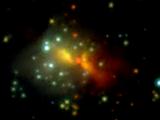
|
14/11/2016
Un estallido estelar revela el mecanismo de formación de las estrellas masivas Un estallido estelar revela el mecanismo de formación de las estrellas masivas |
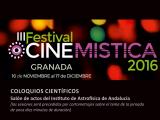
|
14/11/2016
Sesiones de divulgación sobre el azar en la ciencia Cinemística. Sesiones de divulgación sobre el azar en la ciencia |

|
17/11/2016 - 12:30
The CaII triplet in Quasars: from the accretion disk to the star formation Active galactic nuclei (AGN) show a great diversity of optical and UV emission line properties. Dynamical and physical models should be built accordingly. The presence of strong FeII emission suggested the existence of a region shielded from high energy photons, where the low ionization lines are emitted. Mary Loli Martínez Aldama |

|
01/11/2016
IAA International Office |

|
10/11/2016 - 12:30
Very High Energy gamma rays from AGNs: key for AGN structure and cosmological studies The key for AGN structure and cosmological studies. Dr. Josefa Becerra |
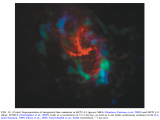
|
09/11/2016 - 12:00
Star Formation Close to and Accretion onto the Supermassive Black Hole Sgr A* The environment of Sgr A* provides a window to the close-up study of star formation under extreme physical conditions Prof. Farhad Yusef-Zadeh |
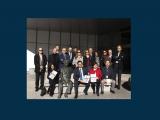
|
08/11/2016
El Instituto de Astrofísica de Andalucía participa en la candidatura de Granada como "Ciudad de la Ciencia" El Instituto de Astrofísica de Andalucía participa en la candidatura de Granada como "Ciudad de la Ciencia" |